I just spent about 20 minutes trying to cut through a PCB with a hacksaw. These things are really tough.
What is the correct tool to cut PCB material, and get a nice straight line?
I saw something about a guillotine, but can't find a vendor.
I just spent about 20 minutes trying to cut through a PCB with a hacksaw. These things are really tough.
What is the correct tool to cut PCB material, and get a nice straight line?
I saw something about a guillotine, but can't find a vendor.
I don't know if this is the best way, but I usually score it multiple times with a heavy-duty knife (on both sides) and snap it by hand. Obviously this won't work for any non-straight cuts. The knife I use is similar to one of these 
The first thing I should mention is safety. You need to wear breathing protection since the dust created by cutting is very hazardous to breathe. Safety glasses should always be worn. As Norm would say -- read and understand all the manufacturers' instructions for your tools.
I use either a hacksaw, bandsaw or tin-snips. Since I primarily use the bandsaw for wood I only use it if the blade needs to changed anyways. After cutting 10 linear inches of FR4 the blade will be useless for wood. I hate changing bandsaw blades.
Hacksaw is what I usually use. I leave 50mils between board edges. I place copper no closer than 25mils to the edge. The hacksaw blade is apx 35mils wide. I use a magnifying visor. This is fine for prototypes.
Sometimes I snip the edges with tin-snips. A scroll-saw would be ideal. Quick change carbide blades. Also I have heard of people using shears.
I finally settled on a wet tile saw. Turns out that it's not much different than the PCB saws that many places use to cut PCBs. A cheap wet tile saw from Harbor Freight costs about $70 (I got mine for $45 on sale), plus another $12 for the blade. The blade cuts a little over 1/16th of an inch, and with the saw guides I can cut very accurately. I also purchased a foot switch so I can cut PCB batches pretty quickly.
The advantage of a wet saw is that the dust is hardly a problem - it's trapped in the water, so while you still should wear protective equipment, you won't end up with fiberglass dust everywhere.
Further it's a very nice, ground cut. Very smooth - it's no different than the edges that were routed or sawn at the PCB fab house. I usually use a fine sandpaper to break the edges (which are a bit 'sharp') afterwards if I think people are going to be handling the PCB a lot.
The water poses no problem to the PCB itself, and if you already mounted components, most are washable. If you need to use it immediately a quick blast with the air hose or canned air removes all the water.
I score it deeply with a Stanley knife on both sides and snap it, as well. A tungsten carbide tile cutter also works, but I prefer the Stanley knife. It blunts the blade very quickly, I resharpen mine with a diamond hone and can keep using the same blade indefinitely.
While many of these have already been addressed I'll put my 2 cents worth in as I have had some good and bad experiences with this problem.
All of the basic options like Hacksaw, coping saw, tinsnips and scoring with a knife work for small jobs they are not my favourite for larger scale runs.
If you are just blanking out a large sheet for etching/developing etc. then a PCB guillotine, as you stated, is good for quick, straight and accurate cuts. See http://www.getlofi.com/ How We Make Circuit Boards – Video November 5th, 2009 entry for good vids on DIY PCB manufacturing including how they cut boards down. Farnell carry PCB specific guillotines but they are frighteningly priced, further googlage to the effect of "PCB guillotine" might elicit cheaper results. If you want to try paper guillotines Officeworks or other stationary suppliers will carry them for ~$60AU but I cannot vouch for this method.
When I was working at a signshop and had small circuits to produce I would use a bandsaw for all my cuts (including straight cuts, takes practice or a jig or both). As stated by jluciani safety should always be considered first! Wear a good breathing mask and not just a cheap one, just don't bother if your not going to spend the money and get a proper mask! I say this from experience because I developed breathing problems when I worked in this environment and the company didn't look after my health, lesson: look after yourself. If you can smell the fibre glass then you are breathing it in!!! Use an extractor too, even if you can't get a fancy industrial one Gaffer tape the hose of a normal vacuum to the table and you will eliminate most dust. Small bandsaws are available from Bunnings warehouse and Total Tools Industrial in Australia and should be available worldwide from any good industrial tool suppliers.
I hope this helps :)
I use a big scissor (originally meant for metal sheets, I don't know the english name, see the picture)

that's perfect for the scope.
Like thisismyrobot, I tend to use a very sharp blade and a straight edge to "score & snap" boards with straight edges. Generally when I'm doing a board at home, rectangular boards are fine.
If I'm doing a circular or odd shaped board for an enclosure, I'm usually sending it out anyway, at which point I have the board house do it for me.
As others have said, if you do anything (grinding, sawing) that generates dust, be damn careful, use breathing protection. Preferably do it outside in an open area.
If you have access to one, a router table with a straight bit will do a great job. You can probably pick up a decent router and table used for a reasonable price (varies by location) and they don't take up much space. The table allows you to assure your boards are squared, and the router itself will allow you to make funky shapes if you wish.
IT's a bit more involved than, say, an Xacto knife or tin snips, which also work quite well, but the results are really great and very quick. If you plan on processing a lot of boards, it's worth the investment.
Nice cordless dremel tool like the 300 works fantastic.
The various cut off wheels work great on lots of other hobby chores/cuts.
I prefer a 'nibbler', at least for small jobs it's ideal. I don't know if they all have a square cutting bit, but mine does, and it's fairly easy to cut in a straight line just free-handing it. The downside is that it takes a swath about an 1/8" wide, but for many purposes this is not a problem. Just google 'nibbler tool'. I got mine at a local retailer (RS) ten years ago, it's held up well.
How about a sharp hacksaw? That's what I've always used. (Although I'll admit that I wasn't aware that the dust was THAT toxic; I'll be more careful next time. )
I can cut a small chunk out of a 4x5" piece of protoboard (about 12" of cuts) in less than 5 minutes, and not working that hard! Are you trying to do a multilayer/thick copper board, or making a great many cuts?
The alternative is to specify a long row of via-size holes (perhaps supplementing with routed cuts) in your PCB, if you're having it manufactured. Just read up on your board house's rules, put some holes in a row, and you can snap the board with your hands. Leaves a ragged edge, but not that much worse than a hacksaw. That's how we do it at work, at least.
I use a scroll saw for weird cuts on boards I create. It just depends on what design your going for. Sometimes just a box cutter and snapping it over a hard edge is all I need for straight cuts.
Shears/guillotines seem under-represented among the answers. Farnell has some PCB shears, but they can be quite expensive.
Looking for lower-cost alternatives, I encountered a review by Brooke Clarke of the Enco 130-5700 12" bench-top plate shear.
I haven't tried one yet, but a shear would be a good alternative to cutting or sawing which produce noise/mess.
The best way? A bench notcher, it can cut through sheet metal a few mm thick and does great on PCBs leaving nice straight lines. I would use these to shear off PCBs and it could cut straight enough to not short adjacent layers
I've always used 1.6mm copper clad but I have always been a bit dissapointed at the options available.
I have tried the following methods:
I've had some excellent results using a metal shear, which are about a third of the price of the cheapest PCB shear I have found.
Hammer and Chisel? a small wood chisel can score in as far into the plastic as you want, i didn't have time to test it thoroughly, but it seems it's great at right angles from the glass fiber in the board and lengthwise. dont know if it handles obliques okay.
Here is a pic, i started with the snappy looking bit in middle of the hole, that was intentional, but the other bit was very straight and took about 10 seconds to get that.